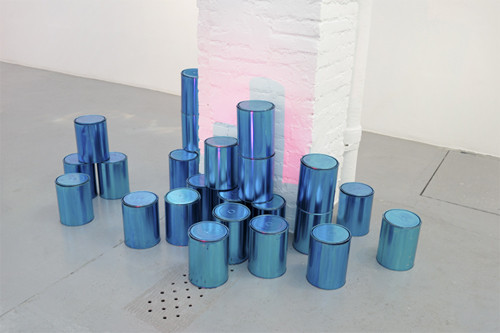Tsuruko Yamazaki
13 Mar - 30 Apr 2010
TSURUKO YAMAZAKI
“Beyond Gutai 1955-2009”
13 March – 30 April 2010
This exhibition, the first of Tsuruko Yamazaki’s in France, features new work made of tin and canvas specifically made for this exhibition as well as early works that originally marked her ingenuity. This opportunity provides a rare chance to view Yamazaki’s unique artistic path of over six decades.
Tsuruko Yamazaki, born in 1925 was a founding member of the avant-garde collective Gutai (Gutai Art Association, 1954-1972) that, under the unorthodox leadership of Jiro Yoshihara, explored radical and experimental methods in search of a new visual language. Seizing the reflective qualities of the hard-edged metal tin, Yamazaki demonstrated a variety of inventive styles that include works such as: The Cans, 1955, made from thirty tin cans painted with pink dye and installed randomly on the floor, and Work, 1957, consisting of crushed tin sheets on the wall with colored gelatin lights on the floor. Exhibited in a series of legendary exhibitions organized by the Gutai between 1955 and 1957, these seminal works exude a glittering presence where material, light, color and form are unified for maximum visual and sensual effects.
In her subsequent series of paintings on canvas from the 1960’s, Yamazaki emulated the mesmerizing power generated by the diffused reflection of tin, in which brightly colored, geometric and biomorphic forms collide and overlap on the surface evoking a dynamic, multi-dimensional reality. At the core of these delirious experiments, beyond what art critic Michel Tapié called „confusion”, there is Yamazaki’s genuine curiosity in unraveling the nature of trans-dimensional perception well beyond logic.
This enlightening vision continues to propel her work today resulting in fully unexpected and playful twists, turns and returns.
Yamazaki’s early works from the Gutai period have been shown in many survey exhibitions of Japanese Contemporary art including: „Japon des Avant-gardes 1910-1970, at Centre Georges Pompidou in 1986, La Biennale di Venezia in 1993 and 2009. In 2004, the first retrospective exhibition was held at Ashiya City Museum of Art and History, Japan. And yet, her work as an individual artist beyond the Gutai period has remained mostly unknown internationally.
“Gutai” literally means „concrete” in Japanese, but the group’s use of the name actually comes from the collective’s determination to „create art that proves our spirits are free. Beyond Gutai, Yamazaki is the true embodiment of that very spirit.
“Beyond Gutai 1955-2009”
13 March – 30 April 2010
This exhibition, the first of Tsuruko Yamazaki’s in France, features new work made of tin and canvas specifically made for this exhibition as well as early works that originally marked her ingenuity. This opportunity provides a rare chance to view Yamazaki’s unique artistic path of over six decades.
Tsuruko Yamazaki, born in 1925 was a founding member of the avant-garde collective Gutai (Gutai Art Association, 1954-1972) that, under the unorthodox leadership of Jiro Yoshihara, explored radical and experimental methods in search of a new visual language. Seizing the reflective qualities of the hard-edged metal tin, Yamazaki demonstrated a variety of inventive styles that include works such as: The Cans, 1955, made from thirty tin cans painted with pink dye and installed randomly on the floor, and Work, 1957, consisting of crushed tin sheets on the wall with colored gelatin lights on the floor. Exhibited in a series of legendary exhibitions organized by the Gutai between 1955 and 1957, these seminal works exude a glittering presence where material, light, color and form are unified for maximum visual and sensual effects.
In her subsequent series of paintings on canvas from the 1960’s, Yamazaki emulated the mesmerizing power generated by the diffused reflection of tin, in which brightly colored, geometric and biomorphic forms collide and overlap on the surface evoking a dynamic, multi-dimensional reality. At the core of these delirious experiments, beyond what art critic Michel Tapié called „confusion”, there is Yamazaki’s genuine curiosity in unraveling the nature of trans-dimensional perception well beyond logic.
This enlightening vision continues to propel her work today resulting in fully unexpected and playful twists, turns and returns.
Yamazaki’s early works from the Gutai period have been shown in many survey exhibitions of Japanese Contemporary art including: „Japon des Avant-gardes 1910-1970, at Centre Georges Pompidou in 1986, La Biennale di Venezia in 1993 and 2009. In 2004, the first retrospective exhibition was held at Ashiya City Museum of Art and History, Japan. And yet, her work as an individual artist beyond the Gutai period has remained mostly unknown internationally.
“Gutai” literally means „concrete” in Japanese, but the group’s use of the name actually comes from the collective’s determination to „create art that proves our spirits are free. Beyond Gutai, Yamazaki is the true embodiment of that very spirit.

